Plants
1. Defining characteristics
- Multicellular, photosynthetic autotrophs
- Protect embryos
2. Some consider there to be green, red, and brown plants
- we will NOT include the red and brown with the plants here
- we will consider the "red plants" and the "brown plants" to be algae
(which we already discussed)
- red algae - Phylum Rhodophyta
- brown algae - Phylum Phaeophyta
- in our discussions we will consider plants to just be the green plants
3. Green plants are most closely related to the green algae
(green algae = Phylum Chlorophyta)

Actually, green plants evolved from ancient forms of green algae:
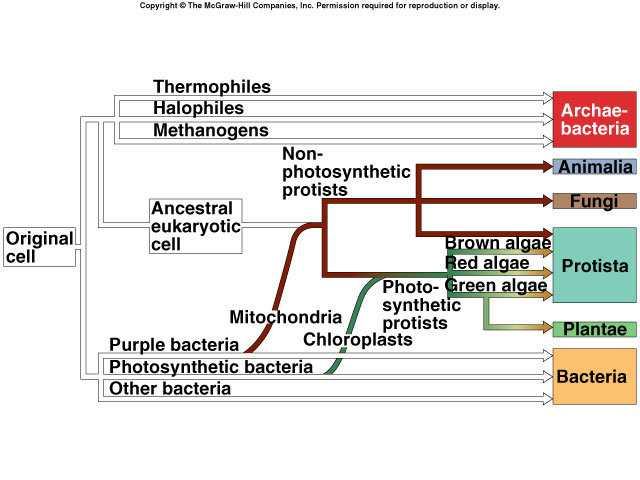
4. Where do plants live?
- Mostly on land - plants are the dominant autotrophs on land
- There are also many species of plants in fresh water
- green algae (which are not plants) are also abundant in freshwater
- freshwater algae are mostly either single-celled or filamentous
- A small number of species of plants live in saltwater - mostly these are seagrasses
- most of the plant-like organisms in marine (saltwater) habitats are green, red, or brown algae
5. The major groups of plants are characterized based on certain major characteristics
- non-vascular vs. vascular
- reproduction via spores vs. seeds
- cones vs. flowers and fruits
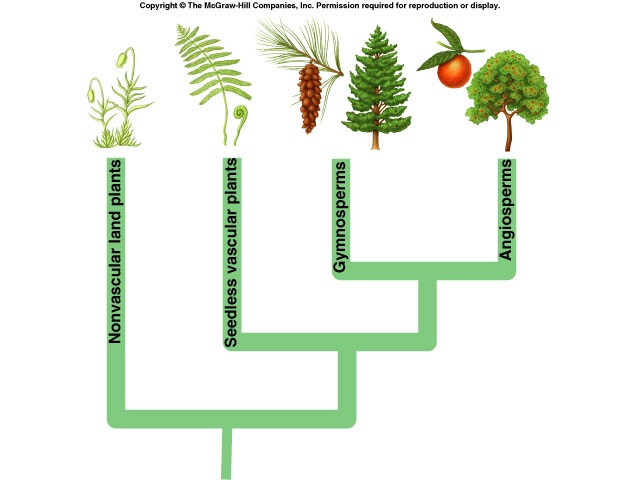
6. Adaptations to land
- Most plants are protected from desiccation by a waxy cuticle secreted on exposed surfaces.
- limits gas exchange essential for respiration and photosynthesis
- gas exchange occurs via stomata
- Evolution of leaves resulted in increased photosynthetic area
7. The plant life cycle is haplodiplontic.
- Diploid generation (sporophyte) alternates with haploid generation (gametophyte)
(referred to as alternation of generations)
- Diploid sporophyte produces haploid spores by meiosis
- Spores divide by mitosis, producing a multicellular, haploid gametophyte.
- Haploid gametophyte is produced by mitosis, and is the source of gametes
gametes fuse to form diploid zygote
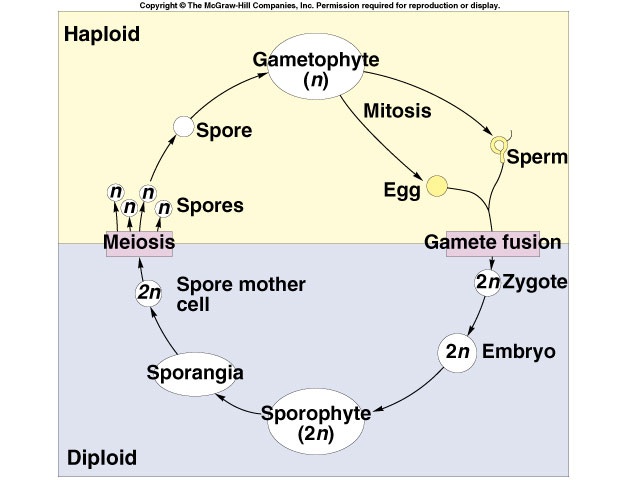
8. Major groups of plants:
Bryophytes - Mosses, Liverworts, and Hornworts
- highly adapted to terrestrial environments
- gametophytes are photosynthetic
- sporophytes are attached to, and nutritionally dependent on, gametophytes
- require water to reproduce sexually
Mosses (Bryophyta)
- Gametophytes typically consist of small, thin, leaf-like structures arranged spirally or alternately around a stem-like axis.
- anchored to substrate by rhizoids
- most of water used by plant travels up outside of plant.
- Many species can withstand prolonged periods of drought, and most mosses are very sensitive to air pollution
- A typical moss:
- the green "leafy" part is the haploid gametophyte generation
- the stalks with spore capsules are the diploid sporophyte generation
- sporophytes grow on and are nourished by the gametophytes!
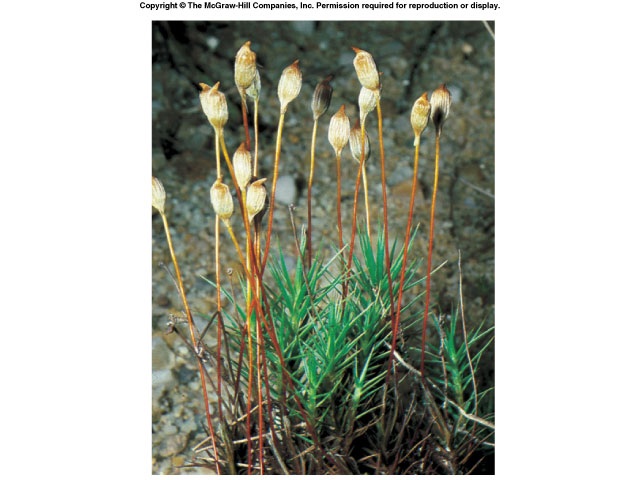
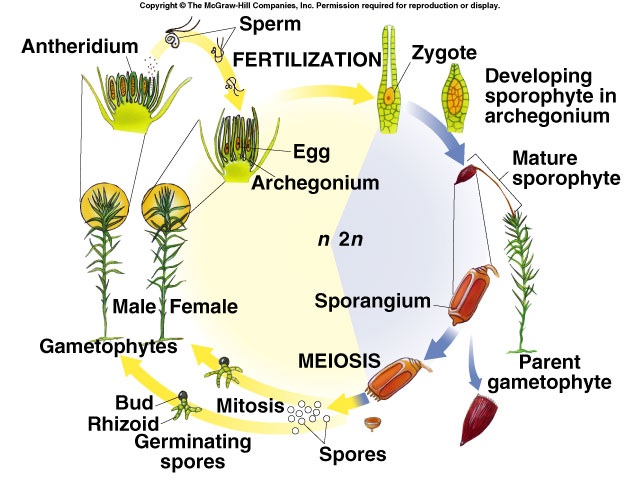
Other bryophytes include liverworts and hornworts
- Hornworts (Anthocerotophyta)
- among earliest land plants
- Sporophyte has stomata, is photosynthetic, and provides much of plant’s energy.
- photo and another photo
Vascular Plants
- Vascular tissues consist of specialized cylindrical or elongated cells that form a network throughout plant.
- xylem - conducts water and dissolved minerals upward from roots
- phloem - conducts sucrose and hormone signals throughout the plant
Seedless vascular plants
The earliest vascular plants lacked seeds. Currently living representatives of these groups include:
- club mosses (Lycophyta)
- relicts of earliest vascular plants
- most abundant in tropics and moist temperate regions
- Horsetails
- single genus, Equisetum
- Sporophytes consist of photosynthetic stems arising from underground rhizomes.
- Ferns
(and more photos, some of which are not true ferns)
- Ferns are the most abundant group of seedless vascular plants.
- About 11,000 living species, 75% occurring in tropics
- Life cycle differs from that of a moss
- greater development, independence, and dominance of fern’s Sporophyte
- Fern sporophytes typically have a horizontal underground stem, the rhizome.
- but some grow upright to tree sizes! - tree fern
- most homosporous, producing sporangia in clusters, sori, on back of fronds
- Diploid spore mother cells in each sporangium undergo meiosis, producing haploid spores.
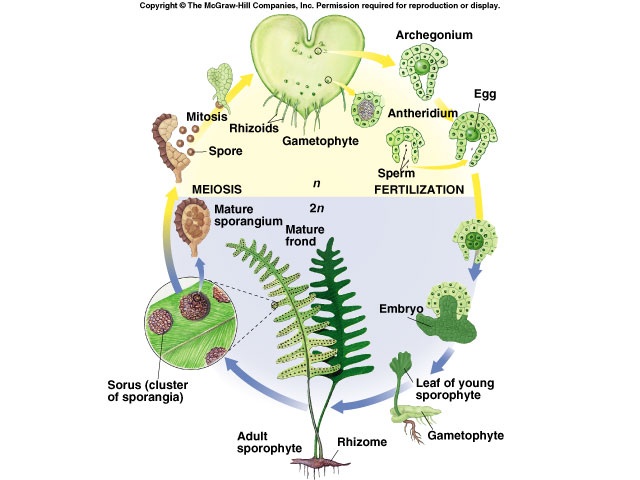
Seed Plants
Seed Plants first appeared about 425 mya.
- drought protection
- enhanced dispersal
- dormant phase
- increase embryo survival by waiting for favorable environmental conditions
Gymnosperms
- Ovule rests exposed on a scale and is not completely enclosed by sporophyte tissues at time of pollination
- Lack flowers and fruits of angiosperms
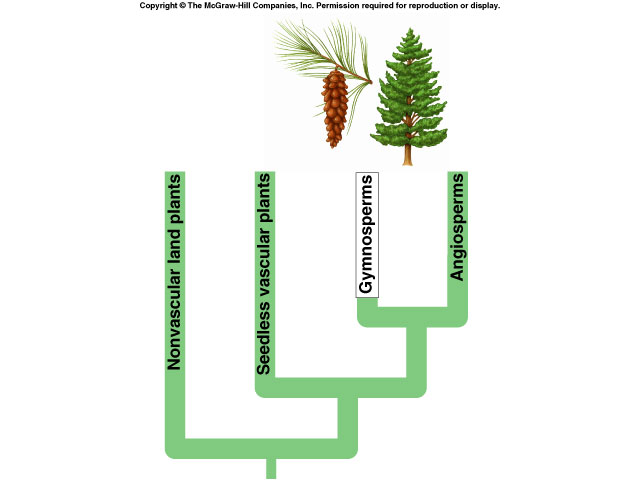
- Four living groups of gymnosperms
- conifers
- cycads
- gnetophytes
- Ginkgo
Conifers (Coniferophyta)- include
- pines
- spruces
- cedars
- hemlocks
- yews
- larches
- cypresses
- others
- pines
- currently more than 100 species
- various species of pines are native to North America and many other regions around the world
- Pines have tough, needlelike leaves produced in clusters
- thick cuticle and recessed stomata
- leaves have canals into which surrounding cells secrete resin
- deters insect and fungal attack
- produce turpentine and rosin
- Wood consists primarily of xylem tissue.
- Pines and other conifers are Heterosporous
- Female cones typically produced on upper branches of the same tree that produces male cones.
- Two ovules develop on each scale. Each ovule contains a megasporangium (nucellus)
- surrounded by integument
- opening - micropyle
- one layer becomes seed coat
- While scales of female cones are open, pollen grains drift down, and some are caught in fluid from the micropyle.
- While female gametophyte is developing, a pollen tube emerges from pollen grain and digests its way to the archegonia.
- Fifteen months after pollination, pollen tube reaches archegonium and discharges its contents.
Pine Lifecycle Diagram
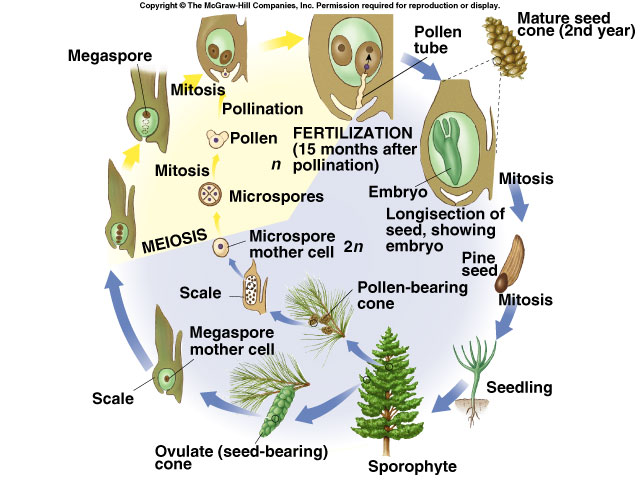
Cycads - gymnosperms that look sort of like palm trees - with cones!
- slow-growing - tropical and sub-tropical (including a few species in the southern U.S.)
- some species get very large
- in prehistoric times much more abundant and much more diverse than now
- many Cycad species are now in decline (due to habitat loss, etc) - many threatened and endangered species
- see this page, and this
Gnetophytes - gymnosperms that don't at first glance look like gymnosperms!
Ginkgo (Ginkgophyta)
- an ancient group that has only one living species - maidenhair tree (Gingko biloba)
- see this page, and this
A few of the cool, interesting, and useful things about Gymnosperms:
- Conifers are our major source of wood for construction and for paper
- Turpentine is distilled from conifers
- Sources of various drugs/medications
- Ephedrine from Ephedra - now we use a synthetic form called psuedephedrine
- Taxol from yew trees (Taxus species)
- etc.
- Limited uses as food, but
- Ginkgo seeds are eaten in China - but are toxic if not properly prepared
- Pine nuts are important foods in some parts of the world (generally these come from species of pines that grow in arid areas, so they have very large seeds with large amounts of energy (fats especially) to aid establishment of seedling).
- juniper "berries" used as flavoring (e.g. in gin)
- The conifers include some of the extremes of the plant kingdom:
Angiosperms - Flowering plants -
- MOST of the plants you eat and are familiar with are angiosperms
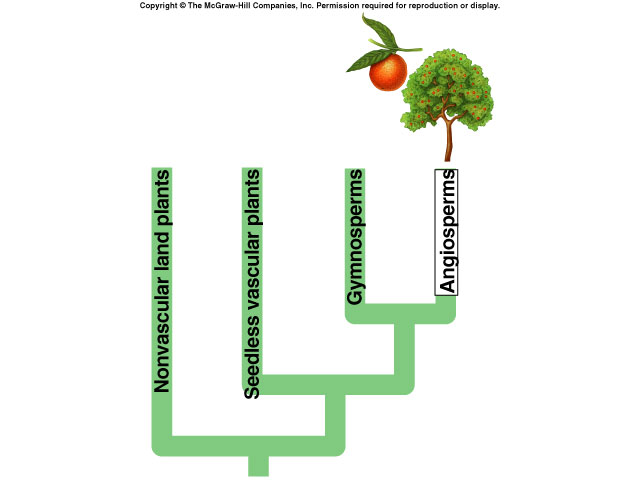
Angiosperms:
Ovules are enclosed within diploid tissues at time of pollination
- carpel, modified leaf encapsulating seed, develops into fruit
Two major groups of angiosperms - Monocots and Eudicots
- eudicots and monocots differ in:
- number of cotyledons - 2 vs. 1
- leaf venation - branching network of veins vs parallel
- presence lateral meristems - absent from most monocots
- number of flower parts - multiples of 4 or 5 vs. multiples of 3
Structure of flowers:
Flower originates as a primordium that develops into a bud at the end of a pedicel.
- expands at tip into a receptacle to which remaining flower parts are attached
- attached in whorls
- outermost whorl - sepals
- second whorl - petals
- Third whorl - stamens (androecium)
- Each stamen consists of pollen-bearing anther and a stalk (filament).
- gynoecium - consists of one or more carpels located at flower’s center
- regions of carpel
- ovary - contains ovules and develops into fruit
- stigma - sticky top
- style - connects stigma and ovary
Anatomy of a flower
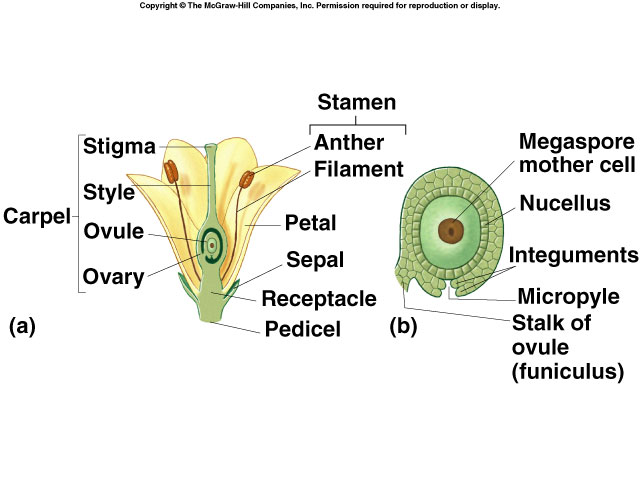
Angiosperm life cycle:
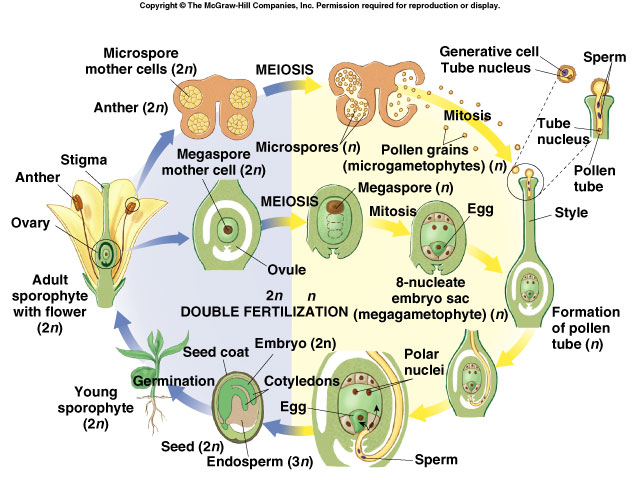
- eight nuclei arranged in two groups of four
- integuments differentiate into seed coat
- one nucleus from each group migrates toward center and functions as polar nuclei
- one cell functions as the egg, and the other two are synergids
- pollination - mechanical transfer of pollen from anther to stigma
- may be followed by fertilization
Fertilization in angiosperms:
As the pollen tube enters the embryo sac, it discharges its contents.
- double fertilization
- One sperm unites with the egg and forms a zygote.
- The other sperm and and two polar nuclei unite, forming a triploid primary endosperm nucleus.
- nutrient supply for embryo
Most plants are hermaphrodites, but some have separate sexes (or separate gender flowers on same plant in some cases).
Transfer of pollen occurs by various means
- Insects are most important pollinators
Some insects are relatively unspecialized "mess and soil" pollinators who come to eat pollen and/or nectar and/or the flowers themselves
e.g. some beetles, many flies, etc (see photo of soldier beetle)
Some insects are specialized for feeding on nectar
e.g. butterflies and moths, and others
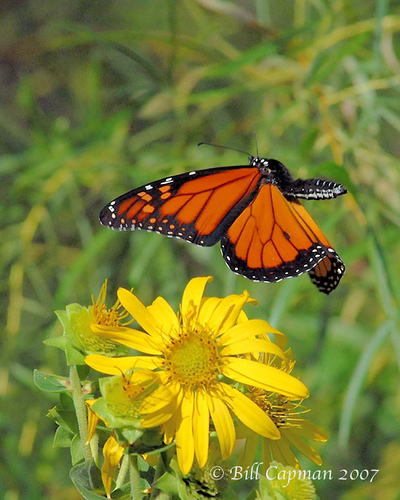

(monarch photos by Bill Capman)

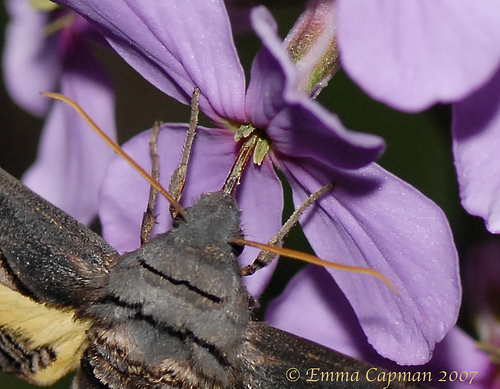
Some insects are highly specialized for feeding on pollen and nectar
bees - adults eat nectar, and collect pollen to feed to larvae

Some insect-pollinator relationships are highly specific - e.g. the pollinators of orchids (we will see a video on this later in the semester)
Some birds are important pollinators
hummingbirds (native to new world only)
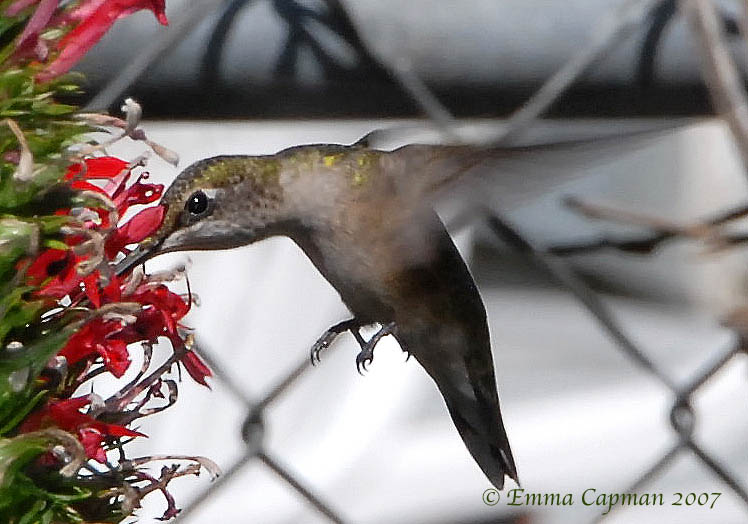
sunbirds - South Africa (sunbird pollinating bird of paradise flowers, another bird of paradise flower)
honeycreepers - Hawaii (and nearly extinct now)
etc.
Some plants are pollinated by mammals
e.g. bats pollinate Saguaro cacti (and another photo), Agave (nice bat photos!), and other plants
bat pollination is most common in the tropics
other mammals - e.g. rose apple is mammal pollinated
Water - this is uncommon, but...
Some seagrasses release pollen into the water, and pollination occurs underwater
In the freshwater plant Vallisneria - male plants break free and float like rafts carrying pollen to female flowers at water surface!
In angiosperms, the ovary wall develops into the fruit
- Fruits vary dramatically
- multiple, varied solutions to the problem of protecting and/or promoting the dispersal of seeds
- See this overview of fruit diversity
















